Themes > Features
16.04.2002
The Medium Term Exim Policy, 2002-07
There is no question
that a medium-term strategy for trade policy is generally to be
welcomed. Obviously, exporters and importers, as well as producers of
import substitutes, would prefer (even require) some degree of policy
stability in order to make plans and investments. But even the
government needs to have a medium-term plan and framework in mind –
indeed, the whole purpose of five-year planning was precisely that, to
ensure not just consistency of strategy across various sectors but also
a vision over the medium term.
So, the Commerce Ministry's decision to announce a medium-term Exim Policy, valid until 2007, is a positive step. Unfortunately, however, the Policy announced does not show adequate vision for the medium term period, apart from declaring very ambitious goals in terms of targets to be fulfilled. It is not very clear about the mechanisms through which these targets are to be achieved, and tends to fall back instead on the hoary (and mistaken) belief that unshackled private initiative will be sufficient to meet the goal of much higher export growth. Therefore it is unlikely that this will prove more successful than other such policy steps of the recent past, which have been associated with decelerating exports and greater import penetration in important sectors of the economy.
The external trade context
First, let us examine the overall context within which the new Exim Policy has been announced. It comes after a decade of very drastic policy changes with respect to both imports and exports since 1991. It is well known that the external sector – in the form of a balance of payments crisis in 1990-91 – was the proximate cause of the push towards neo-liberal economic reform that dominated the 1990s. In addition, the orientation of the economic reform programme was largely external, in terms of attempting to make the Indian economy more "competitive" in international trade terms.
The explicit goals of the economic reform strategy with respect to the external sector, were to create a major shift in the momentum of export growth, and to attract very large inflows of foreign capital (particularly in the form of export-oriented FDI) to augment domestic savings and therefore allow much higher rates of gross domestic investment. In actual fact, the reform process accomplished neither of these objectives by the turn of the decade.
Rather, as we have argued in earlier editions of Macroscan, it involved rates of export expansion more or less similar to those of the past, caused much greater import penetration in manufacturing and therefore particular pressure on employment-intensive small-scale industries, and made the economy as a whole much more dependent upon volatile short term capital inflows without really increasing the total inflow of foreign capital in relation to GDP.
The relative lack of success on the export growth front is evident from Chart 1. This shows that the rate of growth of exports over the 1990s was only marginally higher than it has been in the earlier decade, and was substantially lower than was achieved during the bad old "closed economy" days of the 1970s.

Chart 2 shows that imports have grown faster and outstripped export growth over the 1990s. This has meant a substantial increase in the trade deficit, as shown in Chart 3. This reached a peak of nearly $13 billion in 1999-2000. This amounted to 4 per cent of GDP, as apparent from Chart 4. Even by the end of the decade, the trade deficit was higher than 3 per cent of GDP.



The problems on the external trade front have clearly carried over into the recent past. Charts 5a and 5b show that very recent trends in export and import continue to be disturbing. Despite a dramatic fall in oil prices over the past year, imports have increased, mainly due to a significant increase in non-oil imports despite the continuing domestic recession. Meanwhile export growth has slumped, from more than 20 per cent in 2000-01, to just above 1.5 per cent in the past year.

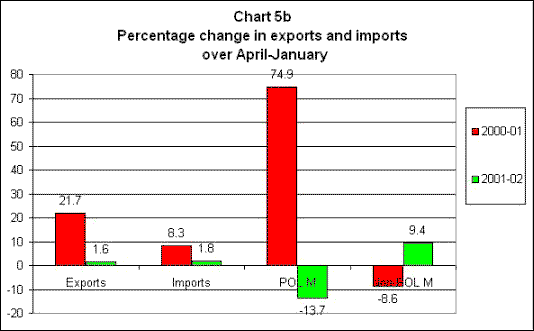
In fact, the most recent data released by the DGCI&S reveal an even more bleak pattern. Aggregate exports in the period April 2001 to February 2002 barely increased at all, registering a pitiful 0.06 per cent rise over the corresponding period of the previous year. Since March is notoriously a bad month for exports, this suggests that exports in dollar terms are likely to have been stagnant over the past fiscal year.
This cannot be seen as a reflection of the poor growth of world markets. It is true that total world merchandise trade slowed down dramatically in 2001, growing at only 2 per cent compared to 12 per cent in 2000. But Indian export growth has been even lower than this - in fact 33 times lower !
Meanwhile, imports have continued to grow – in value terms by 2.3 per cent and by much more in volume terms. Since low world oil prices prevailed over much of the year, this reflects that non-oil imports grew by nearly 9 per cent in value terms, and even more in volume terms, over this period. This obviously means that import penetration continues to affect domestic producers adversely.
Features of the Exim Policy
In this context, it is quite understandable that the Commerce Minister decided to make export growth one focus of the new medium term Exim Policy, which was announced on 31 March. There is no doubt that a successful export thrust in the future will have to be associated with a systematic policy, since it is now clear that relying only on private market-determined responses is inadequate for the purpose.
The objectives of the Exim Policy 2002-07 are clearly ambitious. It explicitly aims to facilitate export expansion such that India's share of world exports reaches at least 1 per cent of world trade by the end of the period. In addition to this it proposes to stimulate sustained economic growth by providing access to essential raw materials, intermediates, components, consumables and capital goods requires for augmenting production and providing services.
The Policy further plans on enhancing the technological strength and efficiency of Indian agriculture, industry and services, thereby improving their competitive strength while generating new employment opportunities. It proposes simultaneously to encourage the attainment of internationally acceptable quality standards. All this would then provide Indian consumers with good quality goods and services at internationally competitive prices.
While this is an optimistic outline of a future paradise for Indian producers and consumers; but the crucial question, of course, is how to get there. The unfortunate reality is the Commerce Minister may have missed the basic point in terms of what determines export growth and improved "competitiveness".
The apparent belief is that even more liberalisation combined with some fiscal concessions will do the trick. However, it is quite clear to most observers – and especially to exporters themselves – that problems of poor and costly infrastructure facilities, and inadequate access to reasonably cheap credit are among the most significant problems currently plaguing Indian producers.
In fact, the Exim Policy statement does not even mention these issues, much less discuss ways in which such problems could be dealt with. One of the most urgent problems for goods exporters relates to the backlog and slow rate of movement through India's ports, which raises costs and affects markets for export goods. The problems of poor transport in general and unstable (and increasingly expensive) access to power and other essential inputs put domestic producers at a major disadvantage compared to their international competitors. Another major area of concern is the difficulty faced by small-scale exporters in raising bank credit, especially after financial liberalisation measures have reduced allocations for priority sector credit.
Obviously, it would be too much to expect the Commerce Ministry alone to tackle these issues. But since these are among the most important constraints on India's exports currently, it was to be expected that the Commerce Minister would take note of these and at least try to co-ordinate with other Ministries such as Power and Surface Transport in order to ensure some cohesive policy with respect to these problems. (Instead, the only co-ordination seems to have been with the Ministry of Finance, and that too, only because the strategy conforms to the Finance Ministry's known approach of preferring tax giveaways to increased public productive expenditure.)
Sustained export expansion requires a more comprehensive and systematic macro strategy on the part of the government, which includes a substantial increase in public infrastructure spending. Such a strategy would also end up improving conditions for producers for the domestic market as well, and therefore aggregate employment conditions.
Indeed, such a systematic and strategic policy would be necessary if the export basket is to be diversified towards more exports that have the potential for greater dynamism in world markets. Over the past decade, the commodity composition of exports (chart 6a & 6b) suggests that this has not occurred so far. But to build a market for Indian products in the world markets requires more than just reliance on private entrepreneurship, as the experience of all successful exporting countries amply demonstrates. It requires systematic government involvement in a variety of forms.
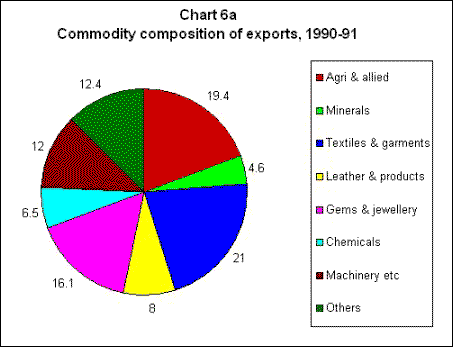
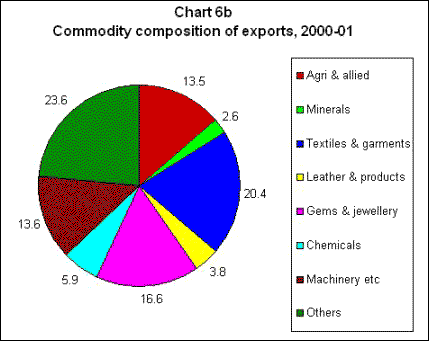
Sadly, the Exim Policy does not appear to have recognised this at all. Instead, it sticks within the now familiar and largely discredited "liberalisation" paradigm, in which it is assumed that deregulation and tax sops will be sufficient to make private producers not only increase production but also improve productivity. This is why the projections of export growth in the so-called "thrust sectors" indicated in Chart 7, are mostly close to past patterns The big increase that is expected is on agricultural exports, following upon anticipated private response to the liberalising measures outlined below.

The trend in India's share of exports (chart 8) in some of these crucial areas is not cause for much optimism. While India's share of world trade in rice and spices has grown, in several other sectors India's share has fallen, sometimes quite sharply.

In fact, the only evidence of some strategic orientation in the current Exim Policy is the launch of the new "Focus Africa" programme, which is certainly welcome. The past direction of trade (indicated in Charts 9a and 9b) suggests that African markets have been greatly neglected by Indian exporters, which is a mistake because Africa (contrary to general perception) has been one of the faster growing regions of the world in the past decade !
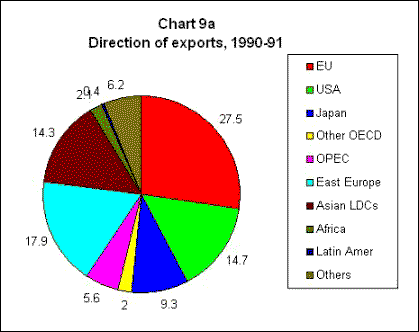
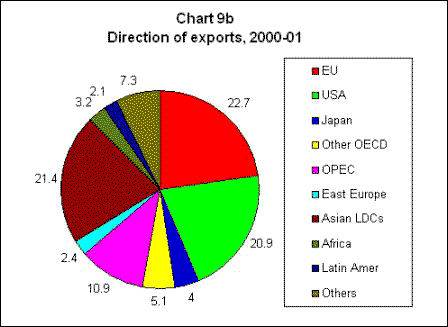
Consistent with the basic market-determined economic strategy framework of this government, the main focus of the new Exim Policy exercise is on a range of measures that will further liberalise the export trade, especially with respect to agricultural exports, and on providing some fiscal incentives including duty neutralisation and other tax sops to exporters. It also relies on more Special Economic Zones, provided with even more incentives, to take up the task of export promotion, even though the experience with Export Processing Zones so far has been dismal.
For agriculture, the Policy contains a number of measures. Quantitative restrictions have been lifted on exports of all commodities except onion and jute. There is provision for a transport subsidy for exports of fresh and processed fruits, vegetables, floriculture, poultry, dairy products and products of wheat and rice. Registration requirements, which were earlier necessary for farm exports, have been removed. The minimum export price condition has been lifted. While these will obviously reduce bureaucratic delays and assist more exports, there are questions about how small cultivators facing large and often monopsonistic distributors would able to manage in the new scenario in which they are to face these forces without any element of mediation.

The Commerce Ministry obviously wants to assist the Food Ministry in getting rid of the embarassingly large public stocks of foodgrains through more exports. It is quite happy to assist in a process which will deprive millions of poor hungry people within India of access to such grain, in order to push this grain out as (implictly) subsidised exports. Of course, this attempt may come up against WTO regulations, so the Exim Policy proposes an internal transport subsidy on movement of foodgrain from FCI godowns to the nearest port, which it believes will bypass the WTO restrictions.
In addition to all this, twenty agri-export zones (AEZs) have been sanctioned, covering mainly horticultural products. Mr. Maran is clearly a keen promoter of such zones : past Exim Policies have witnessed the declaration of various Special Economic Zones. The 13 existing SEZs are also to be allowed to open overseas banking units, which are effectively offshore banks free from domestic restrictions such as those on Cash-Reserve ratio and Statutory Liquidity Ratio. In addition, they have been promised tax concessions as well.

This over-emphasis on agricultural exports can have very deleterious consequences for domestic consumption patterns. Already in the past decade, the rate of growth of foodgrain production has fallen below the rate of growth of population, for the first time since Independence. It is not clear that diversion of cropped area to cash crops will benefit the poor of the country or ensure long-term food security of the country. In fact, the experience of export-oriented agriculture in Sub-Saharan Africa and its consequences is anything but inspiring.
Among the other proposals, "cluster towns" such as Tirupur, Ludhiana and Panipat are also to be provided with similar status, in the form of various fiscal incentives. Thus far, of course, such incentives have not made much difference to the actual export performance of these areas or sectors, although they imply quite a lot of tax revenue foregone in the interests of providing export incentives.
The other main plank of the new Exim Policy is the provision of a range of fiscal concessions and tax sops to exporters under various schemes. Mr. Maran has probably extracted more fiscal sops for exporters than any previous Commerce Minister, even though export performance has not displayed any greater dynamism as a result. Already over the fiscal year just concluded, the revenue loss from the various export promotion schemes is estimated to have been as high as Rs. 23,000 crore or more. In 2002-03, rough calculations suggest that revenue outgo could amount to more than Rs. 27,000 crore, or 60 per cent of budgeted customs duty collection !
It is interesting that this has been allowed by the same Finance Ministry that has prevented increased allocation for public employment schemes that would have increased rural employment, provided rural infrastructure and helped dispose of the excess food stocks. Since revenue foregone is in budgetary terms analogous to increased expenditure, this also means that nearly Rs. 30,000 crore which could have been spent on improving infrastructure conditions even for exporters, has instead been diverted to lining the pockets of some exporters. The past experience with such sops suggests that this would not necessarily lead to increased exports either.
A salutary example is that of gems and jewellery, an export sector that has been a major recipient of fiscal and trade policy sops especially since 1995-96. The import of pearls and semi-precious stones has been liberalised essentially to aid exporters in this sector, who have also received a range of other incentives. Nevertheless, the export performance has not been impressive. As Chart 12 shows, while gross exports have increased, net exports have actually fallen between 1995-96 and 2000-01. In fact, if imports of gold and silver are included, then over the past two years this sector has actually shown a substantial trade deficit in excess of $2 billion annually.

There are many possible objections to the basic philosophy underlying the current Exim Policy, not least because it privileges export growth as the main objective of trade strategy and as the engine of Indian development. But even within this dubious aim, the approach adopted by the Commerce Minister is unlikely to deliver in terms of improved export performance, given past experience. Meanwhile the Policy will mean the wastage of thousands of crores from the public exchequer that could be used for more productive purposes, including for developing a really effective and strategic export promotion policy.
So, the Commerce Ministry's decision to announce a medium-term Exim Policy, valid until 2007, is a positive step. Unfortunately, however, the Policy announced does not show adequate vision for the medium term period, apart from declaring very ambitious goals in terms of targets to be fulfilled. It is not very clear about the mechanisms through which these targets are to be achieved, and tends to fall back instead on the hoary (and mistaken) belief that unshackled private initiative will be sufficient to meet the goal of much higher export growth. Therefore it is unlikely that this will prove more successful than other such policy steps of the recent past, which have been associated with decelerating exports and greater import penetration in important sectors of the economy.
The external trade context
First, let us examine the overall context within which the new Exim Policy has been announced. It comes after a decade of very drastic policy changes with respect to both imports and exports since 1991. It is well known that the external sector – in the form of a balance of payments crisis in 1990-91 – was the proximate cause of the push towards neo-liberal economic reform that dominated the 1990s. In addition, the orientation of the economic reform programme was largely external, in terms of attempting to make the Indian economy more "competitive" in international trade terms.
The explicit goals of the economic reform strategy with respect to the external sector, were to create a major shift in the momentum of export growth, and to attract very large inflows of foreign capital (particularly in the form of export-oriented FDI) to augment domestic savings and therefore allow much higher rates of gross domestic investment. In actual fact, the reform process accomplished neither of these objectives by the turn of the decade.
Rather, as we have argued in earlier editions of Macroscan, it involved rates of export expansion more or less similar to those of the past, caused much greater import penetration in manufacturing and therefore particular pressure on employment-intensive small-scale industries, and made the economy as a whole much more dependent upon volatile short term capital inflows without really increasing the total inflow of foreign capital in relation to GDP.
The relative lack of success on the export growth front is evident from Chart 1. This shows that the rate of growth of exports over the 1990s was only marginally higher than it has been in the earlier decade, and was substantially lower than was achieved during the bad old "closed economy" days of the 1970s.

Chart 2 shows that imports have grown faster and outstripped export growth over the 1990s. This has meant a substantial increase in the trade deficit, as shown in Chart 3. This reached a peak of nearly $13 billion in 1999-2000. This amounted to 4 per cent of GDP, as apparent from Chart 4. Even by the end of the decade, the trade deficit was higher than 3 per cent of GDP.



The problems on the external trade front have clearly carried over into the recent past. Charts 5a and 5b show that very recent trends in export and import continue to be disturbing. Despite a dramatic fall in oil prices over the past year, imports have increased, mainly due to a significant increase in non-oil imports despite the continuing domestic recession. Meanwhile export growth has slumped, from more than 20 per cent in 2000-01, to just above 1.5 per cent in the past year.


In fact, the most recent data released by the DGCI&S reveal an even more bleak pattern. Aggregate exports in the period April 2001 to February 2002 barely increased at all, registering a pitiful 0.06 per cent rise over the corresponding period of the previous year. Since March is notoriously a bad month for exports, this suggests that exports in dollar terms are likely to have been stagnant over the past fiscal year.
This cannot be seen as a reflection of the poor growth of world markets. It is true that total world merchandise trade slowed down dramatically in 2001, growing at only 2 per cent compared to 12 per cent in 2000. But Indian export growth has been even lower than this - in fact 33 times lower !
Meanwhile, imports have continued to grow – in value terms by 2.3 per cent and by much more in volume terms. Since low world oil prices prevailed over much of the year, this reflects that non-oil imports grew by nearly 9 per cent in value terms, and even more in volume terms, over this period. This obviously means that import penetration continues to affect domestic producers adversely.
Features of the Exim Policy
In this context, it is quite understandable that the Commerce Minister decided to make export growth one focus of the new medium term Exim Policy, which was announced on 31 March. There is no doubt that a successful export thrust in the future will have to be associated with a systematic policy, since it is now clear that relying only on private market-determined responses is inadequate for the purpose.
The objectives of the Exim Policy 2002-07 are clearly ambitious. It explicitly aims to facilitate export expansion such that India's share of world exports reaches at least 1 per cent of world trade by the end of the period. In addition to this it proposes to stimulate sustained economic growth by providing access to essential raw materials, intermediates, components, consumables and capital goods requires for augmenting production and providing services.
The Policy further plans on enhancing the technological strength and efficiency of Indian agriculture, industry and services, thereby improving their competitive strength while generating new employment opportunities. It proposes simultaneously to encourage the attainment of internationally acceptable quality standards. All this would then provide Indian consumers with good quality goods and services at internationally competitive prices.
While this is an optimistic outline of a future paradise for Indian producers and consumers; but the crucial question, of course, is how to get there. The unfortunate reality is the Commerce Minister may have missed the basic point in terms of what determines export growth and improved "competitiveness".
The apparent belief is that even more liberalisation combined with some fiscal concessions will do the trick. However, it is quite clear to most observers – and especially to exporters themselves – that problems of poor and costly infrastructure facilities, and inadequate access to reasonably cheap credit are among the most significant problems currently plaguing Indian producers.
In fact, the Exim Policy statement does not even mention these issues, much less discuss ways in which such problems could be dealt with. One of the most urgent problems for goods exporters relates to the backlog and slow rate of movement through India's ports, which raises costs and affects markets for export goods. The problems of poor transport in general and unstable (and increasingly expensive) access to power and other essential inputs put domestic producers at a major disadvantage compared to their international competitors. Another major area of concern is the difficulty faced by small-scale exporters in raising bank credit, especially after financial liberalisation measures have reduced allocations for priority sector credit.
Obviously, it would be too much to expect the Commerce Ministry alone to tackle these issues. But since these are among the most important constraints on India's exports currently, it was to be expected that the Commerce Minister would take note of these and at least try to co-ordinate with other Ministries such as Power and Surface Transport in order to ensure some cohesive policy with respect to these problems. (Instead, the only co-ordination seems to have been with the Ministry of Finance, and that too, only because the strategy conforms to the Finance Ministry's known approach of preferring tax giveaways to increased public productive expenditure.)
Sustained export expansion requires a more comprehensive and systematic macro strategy on the part of the government, which includes a substantial increase in public infrastructure spending. Such a strategy would also end up improving conditions for producers for the domestic market as well, and therefore aggregate employment conditions.
Indeed, such a systematic and strategic policy would be necessary if the export basket is to be diversified towards more exports that have the potential for greater dynamism in world markets. Over the past decade, the commodity composition of exports (chart 6a & 6b) suggests that this has not occurred so far. But to build a market for Indian products in the world markets requires more than just reliance on private entrepreneurship, as the experience of all successful exporting countries amply demonstrates. It requires systematic government involvement in a variety of forms.


Sadly, the Exim Policy does not appear to have recognised this at all. Instead, it sticks within the now familiar and largely discredited "liberalisation" paradigm, in which it is assumed that deregulation and tax sops will be sufficient to make private producers not only increase production but also improve productivity. This is why the projections of export growth in the so-called "thrust sectors" indicated in Chart 7, are mostly close to past patterns The big increase that is expected is on agricultural exports, following upon anticipated private response to the liberalising measures outlined below.

The trend in India's share of exports (chart 8) in some of these crucial areas is not cause for much optimism. While India's share of world trade in rice and spices has grown, in several other sectors India's share has fallen, sometimes quite sharply.

In fact, the only evidence of some strategic orientation in the current Exim Policy is the launch of the new "Focus Africa" programme, which is certainly welcome. The past direction of trade (indicated in Charts 9a and 9b) suggests that African markets have been greatly neglected by Indian exporters, which is a mistake because Africa (contrary to general perception) has been one of the faster growing regions of the world in the past decade !


Consistent with the basic market-determined economic strategy framework of this government, the main focus of the new Exim Policy exercise is on a range of measures that will further liberalise the export trade, especially with respect to agricultural exports, and on providing some fiscal incentives including duty neutralisation and other tax sops to exporters. It also relies on more Special Economic Zones, provided with even more incentives, to take up the task of export promotion, even though the experience with Export Processing Zones so far has been dismal.
For agriculture, the Policy contains a number of measures. Quantitative restrictions have been lifted on exports of all commodities except onion and jute. There is provision for a transport subsidy for exports of fresh and processed fruits, vegetables, floriculture, poultry, dairy products and products of wheat and rice. Registration requirements, which were earlier necessary for farm exports, have been removed. The minimum export price condition has been lifted. While these will obviously reduce bureaucratic delays and assist more exports, there are questions about how small cultivators facing large and often monopsonistic distributors would able to manage in the new scenario in which they are to face these forces without any element of mediation.

The Commerce Ministry obviously wants to assist the Food Ministry in getting rid of the embarassingly large public stocks of foodgrains through more exports. It is quite happy to assist in a process which will deprive millions of poor hungry people within India of access to such grain, in order to push this grain out as (implictly) subsidised exports. Of course, this attempt may come up against WTO regulations, so the Exim Policy proposes an internal transport subsidy on movement of foodgrain from FCI godowns to the nearest port, which it believes will bypass the WTO restrictions.
In addition to all this, twenty agri-export zones (AEZs) have been sanctioned, covering mainly horticultural products. Mr. Maran is clearly a keen promoter of such zones : past Exim Policies have witnessed the declaration of various Special Economic Zones. The 13 existing SEZs are also to be allowed to open overseas banking units, which are effectively offshore banks free from domestic restrictions such as those on Cash-Reserve ratio and Statutory Liquidity Ratio. In addition, they have been promised tax concessions as well.

This over-emphasis on agricultural exports can have very deleterious consequences for domestic consumption patterns. Already in the past decade, the rate of growth of foodgrain production has fallen below the rate of growth of population, for the first time since Independence. It is not clear that diversion of cropped area to cash crops will benefit the poor of the country or ensure long-term food security of the country. In fact, the experience of export-oriented agriculture in Sub-Saharan Africa and its consequences is anything but inspiring.
Among the other proposals, "cluster towns" such as Tirupur, Ludhiana and Panipat are also to be provided with similar status, in the form of various fiscal incentives. Thus far, of course, such incentives have not made much difference to the actual export performance of these areas or sectors, although they imply quite a lot of tax revenue foregone in the interests of providing export incentives.
The other main plank of the new Exim Policy is the provision of a range of fiscal concessions and tax sops to exporters under various schemes. Mr. Maran has probably extracted more fiscal sops for exporters than any previous Commerce Minister, even though export performance has not displayed any greater dynamism as a result. Already over the fiscal year just concluded, the revenue loss from the various export promotion schemes is estimated to have been as high as Rs. 23,000 crore or more. In 2002-03, rough calculations suggest that revenue outgo could amount to more than Rs. 27,000 crore, or 60 per cent of budgeted customs duty collection !
It is interesting that this has been allowed by the same Finance Ministry that has prevented increased allocation for public employment schemes that would have increased rural employment, provided rural infrastructure and helped dispose of the excess food stocks. Since revenue foregone is in budgetary terms analogous to increased expenditure, this also means that nearly Rs. 30,000 crore which could have been spent on improving infrastructure conditions even for exporters, has instead been diverted to lining the pockets of some exporters. The past experience with such sops suggests that this would not necessarily lead to increased exports either.
A salutary example is that of gems and jewellery, an export sector that has been a major recipient of fiscal and trade policy sops especially since 1995-96. The import of pearls and semi-precious stones has been liberalised essentially to aid exporters in this sector, who have also received a range of other incentives. Nevertheless, the export performance has not been impressive. As Chart 12 shows, while gross exports have increased, net exports have actually fallen between 1995-96 and 2000-01. In fact, if imports of gold and silver are included, then over the past two years this sector has actually shown a substantial trade deficit in excess of $2 billion annually.

There are many possible objections to the basic philosophy underlying the current Exim Policy, not least because it privileges export growth as the main objective of trade strategy and as the engine of Indian development. But even within this dubious aim, the approach adopted by the Commerce Minister is unlikely to deliver in terms of improved export performance, given past experience. Meanwhile the Policy will mean the wastage of thousands of crores from the public exchequer that could be used for more productive purposes, including for developing a really effective and strategic export promotion policy.
© MACROSCAN 2002